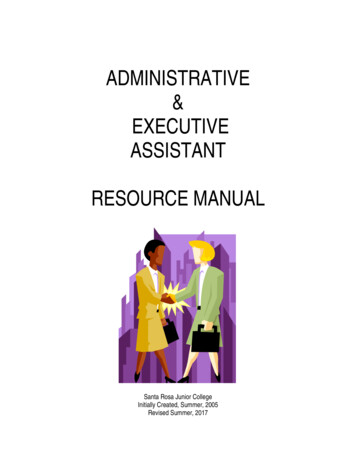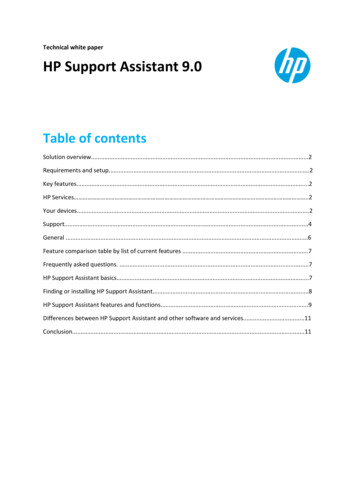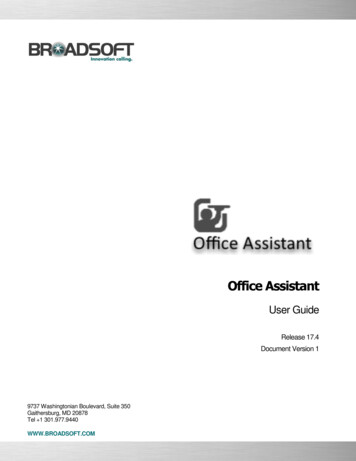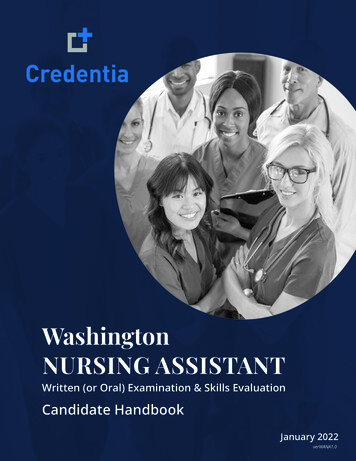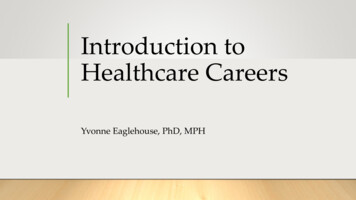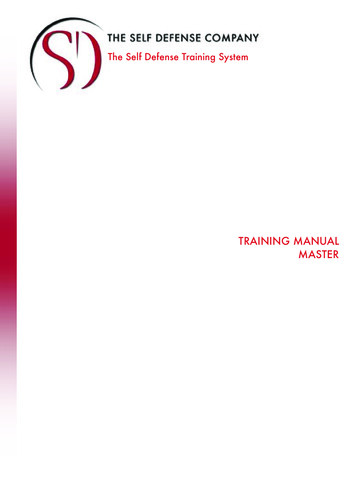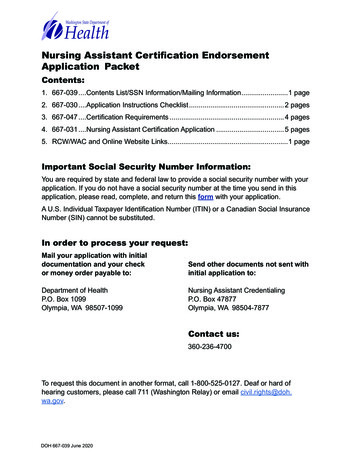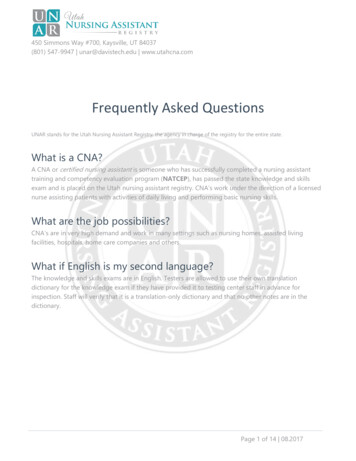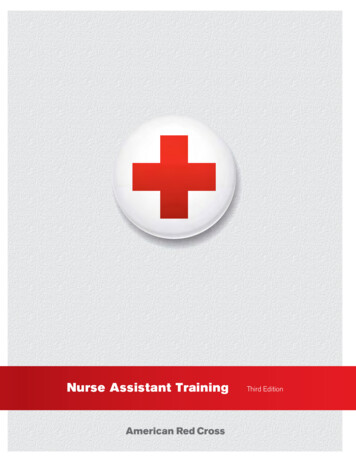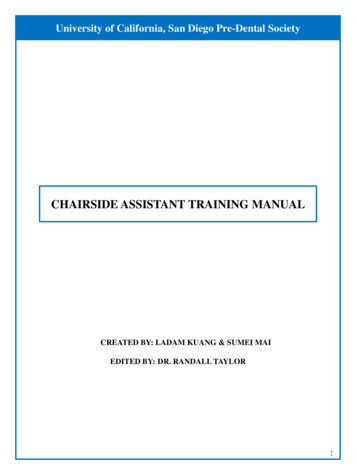
Transcription
University of California, San Diego Pre-Dental SocietyCHAIRSIDE ASSISTANT TRAINING MANUALCREATED BY: LADAM KUANG & SUMEI MAIEDITED BY: DR. RANDALL TAYLOR1
University of California, San Diego Pre-Dental SocietyOBJECTIVE: The objective of this manual is to provide general training fornew chairside volunteers in clinic policies and procedures, and to detail theirroles in facilitating efficient clinic operations. The manual covers the followingtopics:1. Clinic Rules and Attendance . . 32. Roles of the Chairside Assistant . .4 - 73. Oral Anatomy . . .8 - 94. General Suctioning Guidelines .10 - 115. Four-Handed Dentistry Basics . 116. Assisting for Composite Fillings and Extractions .12 – 137. References .142
University of California, San Diego Pre-Dental Society1. Clinic Rules and AttendanceI. Clinic Rules Do not use cell phones in clinic. Conversations should be patient-appropriate and clinic-related. Do notstand around idly if not assisting—ask managers if you can help withanything! Mandatory attire: scrubs, nametag, disposable gowns (one-time useonly!), closed-toed shoes with socks (no UGGs, flats, Crocs, etc). Donot wear excessive and/or dangling jewelry. Hair that is longer than 2inches below the earlobe must be tied up. Maintain infection control via OSHA protocol: Do NOT touchanything considered clean (i.e. cabinets, counters, etc.) with gloveson, even if your gloves are clean! Gloves are always considereddirty. Do NOT touch needles! Make sure to eat before clinic and stay hydrated!II. Clinic Attendance The volunteer scheduler sends out biweekly sign-ups for clinic. It isyour responsibility to check the spreadsheet for your assigned clinicsession. Do NOT be late for clinic! Allot time for possible traffic. If you willbe late, notify the manager ASAP. Three tardies will result in a 3month suspension. If you cannot make it to clinic, it is your responsibility to find areplacement or it will count as a no-show. A no-show will result in a one-month suspension for new volunteersand a three-month suspension for regular volunteers.3
University of California, San Diego Pre-Dental Society2. Roles of the Chairside AssistantI. Pulling patient charts and taking blood pressure All forms in chart must be signed and have patient name on each page Take patient blood pressure. Record it on the next available line in thetreatment form, followed by your initials. Do not skip lines! Look over medical history and present to the dentist any medications,medical conditions (i.e. hypertension, diabetes, etc.), or allergies thatmay be pertinent to the procedure.II. Setting up the dental chair and unit Birex chair (including light) and unit (including tray counter, highspeed evacuator, saliva ejector, air-water syringe, and all tubings).Birex is carcinogenic—Use only with gloves on! Take gloves off. Place barrier tape on light handles, light switch, andchair remote control. Place headrest cover over headrest. Make surelight and chair are functioning. (See page 7 for images) Make sure water reservoir is adequately filled with distilled water. Donot screw reservoir back on too tightly. Place disposable tips on air-water syringe, high-velocity evacuator(HVE, or high-speed suction), and saliva ejector (slow-speed suction).Test the air-water syringe and both suctions. (See page 7 for images) Place plastic sleeves over the tips. Penetrate the plastic sleeves withthe respective air-water syringe tip and suction tips. Arch the salivaejector tip. Let clinic manager know that the chair is ready for the patient. Put onprotective wear: disposable gown, clear goggles/glasses, mask, andgloves.III. Preparing patient for procedures After clinic manager has seated patient (with patient chart) and floormanager has set down instrument tray, place bib around patient (Shinyside down! Fold the top 1-inch of the bib down before clipping formore support).4
University of California, San Diego Pre-Dental Society Give the patient dark sunglasses to protect his/her eyes from thedentist’s light. Have the patient rinse his/her mouth with mouthwash. Make polite conversation with the patient until dentist arrives. Keepconversations appropriate.IV. Assisting the dentist Charting: You will assist the dentist when performing an oral exam.Familiarize yourself with oral anatomy (See page 8)! During procedures, you will be mainly involved with:oUsing the high-speed evacuator and saliva ejector (See pages10 – 11 for general suctioning guidelines)oUsing the air-water syringe (Think WA as in Washington:Water is the left button, used for rinsing a patient’s mouth. Air isthe right button, used for drying a tooth or keeping the dentist’smirror from fogging up)oPassing instruments: Familiarize yourself with the instrumentsfor various procedures with the Instrument Packet available . When passinginstruments, use four-handed dentistry (See page 11 for moredetails)oOther chairside duties for specific procedures are furtherdetailed on pages 12 - 13!V. Breaking down the chair and unit Always break down and set up the chair as quickly as possible formaximum efficiency of the clinic! With gloves on, remove handpieces and cavitron tips and place oninstrument tray. DO NOT TOUCH NEEDLES! Only managers anddentists can handle needles. Remove and dispose of suction tips, air-water syringe tips, andrespective barriers. Make sure to remove only the disposable tip ofthe saliva ejector. Do not remove the rubber tip, it is NOTreplaceable!!5
University of California, San Diego Pre-Dental Society Remove headrest cover and light barriers. Take off dirty gloves and put on clean gloves. Birex the chair and theunit, as well as anything that has been touched (including thesunglasses and bib clips). Do not forget to birex the curing light andcavitron if used! Set up the chair as described in Part II. Run linesbriefly after bloody extractions. If the chair will no longer be used for the current clinic session, youdo not need to replace the light barriers, headrest cover, and thesuction and air-water syringe tips. Instead, run both suction lines withline solution. Take caution when running the lines, do not overwhelmthe vacuum!BirexNote: Use ungloved handto open Birex containerand use gloved hand toretrieve Birex6
University of California, San Diego Pre-Dental SocietyA. Incomplete Chair set-upD. High-velocity evacuator(left) and low speedsuction (right) withrespective disposable tipsand plastic sleevesA.B. Headrest CoverE. Air-Water Syringe withdisposable tip and sleeveC. Barrier tape covers lighthandles and light switch7
University of California, San Diego Pre-Dental Society3. Oral AnatomyI. Tooth AnatomyII. Teeth NomenclatureJARightTA. Permanent Teeth1 – 16 Upper (Maxillary)17 – 32 Lower (Mandibular)LeftKB. Primary TeethA – J Upper (Maxillary)K – T Lower (Mandibular)Note: ―Right‖ and ―Left‖ refers to the patient’s right and left.8
University of California, San Diego Pre-Dental Society4. General Suctioning GuidelinesThe main purpose of the high-velocity evacuator (HVE) is to remove aerosolsfrom the environment and keep the tooth of interest isolated and dry. The mainpurpose of the saliva ejector is to reduce pooling of saliva.I. General Suctioning Guidelines Never place suctions down the middle of patient’s mouth. This willcause the patient to gag or choke. Do not touch the dentist’s instrument or handpiece with the suction! Position the suction so that it does not obstruct the dentist’s mirror orthe dentist’s line of sight, and does not suction intra-oral tissues (i.e.cheek, tongue, lips) An HVE should be placed opposite the side of the handpiece orinstrument. The HVE inlet should be oriented slightly occlusal andlateral to the aerosol source. It should be placed no more than 1-2 cmaway from the aerosol-producing instrument—close enough toadequately reduce aerosols, but not so close that there is excessivepinching or stretching forces on intra-oral tissues. Examples areillustrated below.A. Incorrect suctioning: HVE ispulling the cheek with too muchlateral force, causing discomfort.The HVE inlet is nearly touchingthe handpiece and is too close tothe tongue. (Mandibular molar)B. Correct suctioning: HVE isputting less lateral force on thecheek. The HVE inlet is facing thehard tooth surface and is furtheraway from the tongue.9
University of California, San Diego Pre-Dental SocietyC. Correct suctioning ofmandibular anterior teeth5. Four-Handed Dentistry BasicsFour-handed dentistry is a system for passing instruments between a dentistand his/her assistant that maximizes speed and efficiency during procedures.Pick up the requested instrument with your thumb and index finger and pass itto the thumb and index finger of the dentist, orienting it so that the dentistdoes not need to make further maneuvers to use it properly. At the same time,with your pinky, take away the instrument that the dentist is finished using.A. Four-Handed Dentistry: Chairside assistant (mint-colored glove)takes used instrument with pinky and hands over requested instrumentwith thumb and index finger.10
University of California, San Diego Pre-Dental Society6. Assisting for Composite Filling and ExtractionThis section outlines the basic steps for a composite filling and an extraction.The bulleted points highlight the general role of the chairside assistant ateach step of the procedure.I. Composite filling1. Application of topical anesthetic and local anesthetic Rinse with air-water syringe after application of local anesthetics2. Removal of decay and unsupported tooth structure with high-speedhandpiece Use high-velocity evacuator to reduce aerosol and eliminate waterand residue3. Application of etch Use high-velocity evacuator to keep area isolated4. Application of bonding agent Use HVE to keep area dry and isolated. Cure with curing light.5. Insertion of composite Pass requested instruments using four-handed dentistry. Clean composite instruments with gauze immediately! Curecomposite material.6. Polishing of composite with polishing burs Use high-velocity evacuator to suction residue and reduce aerosol7. Check occlusion with articulating paperII. Extraction1. Application of topical anesthetic and local anesthetic Rinse and suction after application of local anesthetics2. Separation of tooth from periodontal ligament using periosteal3. Expansion of socket and further separation of tooth from ligament/boneusing small/large elevator4. Use of extraction forcep to remove tooth Never remove any tooth fragments from dental tray until theprocedure is finished! This is to ensure that the tooth wascompletely removed and no broken fragments remain in theextraction site.11
University of California, San Diego Pre-Dental SocietyExtraction (Continued)5. Removal of debris or infected tissue from socket6. Compression of socket7. Irrigation of socket and rounding off of any sharp bone edges with bonefile8. Insertion of gauze in extraction site. Possible prescription ofpainkillers/antibiotics. Give patient extra gauze packets. Give patient post-op instructions.12
University of California, San Diego Pre-Dental Society7. References1. Ask Dr. Sun. 5 Mar. 2009. WordPress.com. 29 Sept. 2012 http://sundds.files.wordpress.com/2009/03/1.jpg 2. Amsel, Martyn. ―Working better: Four-handed Dentistry.‖ PPD. 16 Jan. 2012. 29 Sept. 2012 /article/working-better-four-handed-dentistry 2. Riverside Dental Clinic. 1 Aug. 2012. Riverside Dental Clinic. 29 Sept. 2012 http://riversidemdc.com/images/ToothAnatomy.jpg 3. Studio Dentaire. 2011. Studio Dentaire. 29 Sept. 2012 http://www.studiodentaire.com/images/en/primary teeth.jpg 8. Credits:A big thank you to Amy Huang, Amy Huang, and Teny Matavoosi forallowing me to take their photos for the suctioning section and four-handeddentistry section.13
University of California, San Diego Pre-Dental Society 2 OBJECTIVE: The objective of this manual is to provide general training for new chairside voluntee
